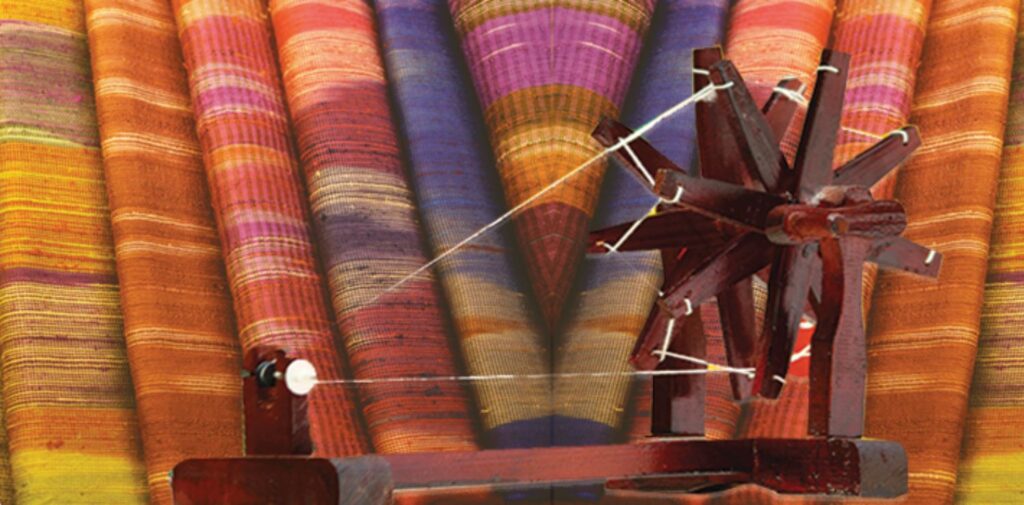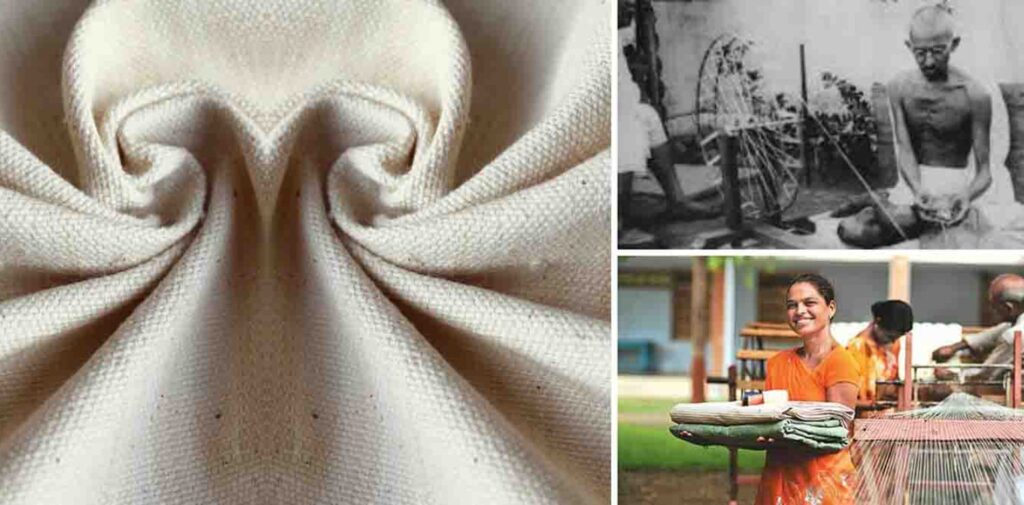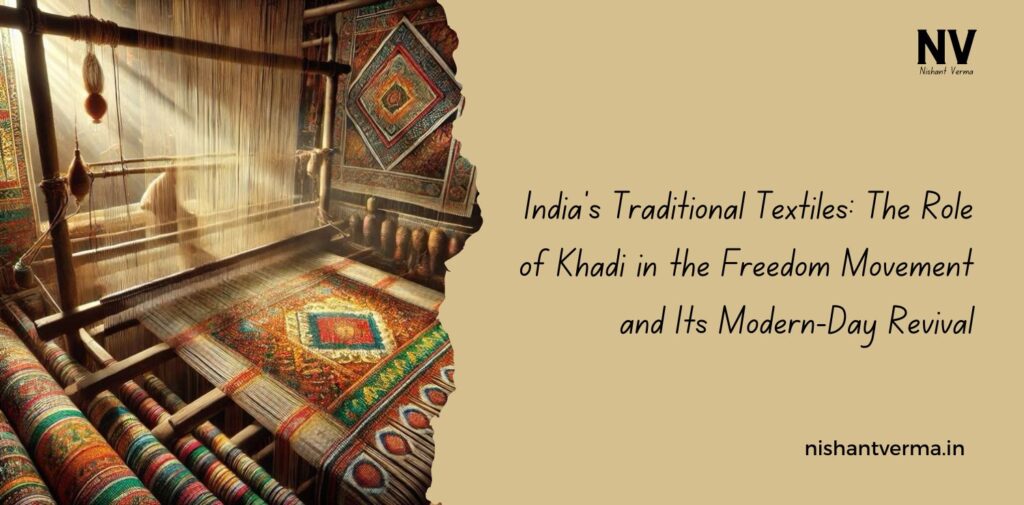India traditional textiles are an integral part of the country’s rich cultural heritage. The fabric of India’s past is woven with stories of creativity, craftsmanship, and resilience, with different regions having their own unique styles and methods of weaving. Among these, Khadi stands out as a symbol of India’s independence movement and continues to play a significant role in the country’s modern textile industry. The journey of Khadi from a fabric of freedom to its current-day revival is a story of resilience, vision, and national pride.
The Origins of Khadi
Khadi, also known as handspun and handwoven fabric, is one of the oldest and most significant traditional textiles of India. The word “Khadi” is derived from the Sanskrit word “Khaddar,” which means coarse cloth made from cotton or silk. However, it was not until the 20th century that Khadi became synonymous with India’s struggle for independence.
Historically, The Khadi was popular across India as a daily fabric used for making clothes. It was woven by hand using simple tools like the spinning wheel (charkha) and the handloom. The fabric was produced by rural artisans, and its production was an essential source of livelihood for many villages. Each region had its own distinctive weaving patterns and techniques. However, with the advent of industrialization in the late 19th century, machine-made fabrics began to dominate, and traditional handloom weaving faced a decline.

Khadi and the Indian Freedom Movement
The most significant chapter in the history of Khadi came with Mahatma Gandhi’s leadership in the Indian freedom struggle. In the early 20th century, India was under British colonial rule, and the country’s textile industry was largely controlled by the British. The British had introduced machine-made textiles into India, which led to the destruction of local industries and the displacement of artisans. The widespread use of imported British goods, particularly textiles, was seen as a major contributor to India’s economic subjugation.
In response to this, Mahatma Gandhi launched the Swadeshi Movement in the early 1900s, encouraging Indians to boycott British goods and instead promote indigenous products. One of the most important aspects of this movement was the promotion of The Khadi. Gandhi believed that Khadi represented both self-reliance and resistance to British rule. He called upon Indians to spin their own cloth on the charkha and wear Khadi instead of foreign-made textiles. This movement was not just a protest against foreign goods but also a way to empower rural communities and provide employment to the impoverished masses.
The charkha became a symbol of India’s independence movement. Gandhi’s call for Khadi was seen as a way of asserting Indian identity and rejecting the cultural dominance of the British. Khadi became more than just a fabric; it became a tool for social, political, and economic change. It symbolized the unity of the people, the self-reliance of the nation, and the fight against exploitation.
Khadi’s importance in the freedom movement was evident in the way it was adopted by leaders, revolutionaries, and common people alike. The simple act of wearing Khadi was a statement of defiance against British colonialism. It symbolized the country’s desire to regain control over its resources and its future. Khadi’s production and consumption became intertwined with the idea of Swaraj (self-rule), and it was an important part of the larger fabric of India’s freedom struggle.
The Decline of Khadi After Independence
After India gained independence in 1947, Khadi continued to hold a special place in the national consciousness. However, in the decades that followed, Khadi’s popularity began to decline. The rapid industrialization of India, combined with the growth of mass-produced textiles, led to the rise of synthetic fabrics and ready-made garments. Khadi, being a labor-intensive fabric, struggled to compete with cheaper, mass-produced alternatives. The younger generation, influenced by modern fashion trends, turned away from Khadi in favor of more contemporary fabrics.
Despite the decline in its popularity, the Indian government made efforts to promote The Khadi through various initiatives. The Khadi and Village Industries Commission (KVIC) was established in 1956 to support the production and marketing of Khadi. However, the fabric was no longer as central to the Indian identity as it had been during the freedom movement.

Modern-Day Revival of Khadi
In recent years, Khadi has seen a remarkable revival, both within India and abroad. This revival can be attributed to a growing awareness of the fabric’s cultural significance, its eco-friendly qualities, and its connection to sustainability.
One of the key reasons behind Khadi’s modern-day resurgence is the growing global emphasis on sustainable fashion. As people become more conscious of the environmental impact of fast fashion and mass production, Khadi offers an attractive alternative. Made from natural fibers like cotton, silk, and wool, Khadi is an eco-friendly fabric that requires minimal use of machines, making it energy-efficient and sustainable. The process of hand-spinning and hand-weaving also ensures that The Khadi has a much lower carbon footprint than factory-made textiles.
Khadi’s revival has been further fueled by the growing interest in promoting indigenous crafts and empowering rural communities. The production of Khadi provides employment to thousands of artisans, particularly in rural areas, where it helps support traditional craftsmanship. As a result, many designers, social entrepreneurs, and organizations are focusing on reviving Khadi as a way to preserve India’s cultural heritage and support rural economies.
The revival of The Khadi is also being driven by contemporary designers and fashion influencers who are reinterpreting the fabric for the modern world. Designers have started incorporating Khadi into high-fashion collections, blending traditional weaving techniques with modern designs. This has helped Khadi appeal to younger generations who are looking for stylish and sustainable alternatives to fast fashion. Khadi’s modern interpretations include everything from casual wear to formal attire, and the fabric is now seen as a symbol of both tradition and innovation.
Government initiatives have also played a significant role in the revival of Khadi. The “Khadi for Fashion” campaign, launched by KVIC, has been successful in promoting the fabric among a younger audience. Additionally, Khadi’s popularity has been boosted by the increasing number of online platforms and retail outlets that market Khadi products, making it more accessible to consumers worldwide.
The influence of prominent figures like Prime Minister Narendra Modi, who has often worn Khadi at official events, has also contributed to the fabric’s growing popularity. Khadi’s association with national pride, sustainability, and rural development has made it a symbol of contemporary India’s values.

Khadi in the Global Context
Khadi’s revival is not confined to India. Around the world, there is growing interest in traditional textiles and sustainable fashion. Khadi has made its way into international fashion markets, where it is appreciated for its unique texture, rich history, and eco-friendly nature. International designers and brands have started exploring Khadi as a textile for their collections, contributing to the global recognition of Indian craftsmanship.
Conclusion: India Traditional Textiles
Khadi’s journey from a symbol of India’s struggle for independence to a modern-day fabric of sustainability and style is a testament to the resilience of traditional craftsmanship and the adaptability of Indian textiles. Today, Khadi is not just a fabric; it is a symbol of self-reliance, environmental consciousness, and national pride. Its revival is not only about preserving a rich cultural heritage but also about embracing the values of sustainability, empowerment, and ethical consumption.
As the world continues to face challenges related to climate change, fast fashion, and economic inequality, Khadi offers a model of a more sustainable and equitable future. By supporting Khadi, both Indians and people across the globe can be a part of a movement that honors tradition while shaping a better, more conscious world.




